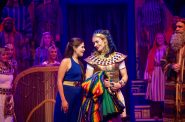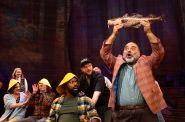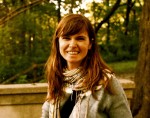On board the Freedom EXPRESSions Bus Tour
NOVA students take learning outside of the classroom and with the help of Arts @ Large, lead an artistic, historical tour of Milwaukee's Civil Rights Movement.

James Groppi and Vel Phillips on school bus, circa 1967-1968; Historical images courtesy of the March on Milwaukee Civil Rights History Project and the Wisconsin Historical Society
“Today NOVA High School students will show you a side of Milwaukee that’s been a secret for far too long. We are going to walk you through Milwaukee 1960s style. We’re going to read letters, listen to speeches, sing songs, and join a council room already in progress.” – Students of NOVA
A group of students from Northwest Opportunities Vocational Academy (NOVA) gathered at the Arts @ Large space in Walker’s Point on a sunny, spring-like Friday in December. Teachers, professors and other members of the public mingled as they waited for their student leaders to guide them on a historic bus tour around the city, making stops at significant sites from the Milwaukee Civil Rights movement of the 1960s.
“We got history class but some of the stuff that’s taught in history may not be taught here, so I wanted to learn more than what’s really taught in the classroom,” said Asia, NOVA student.
This muted history was brought to life by a group of eager students, a couple motivated teachers, and a few community partners including local arts education organization, Arts @ Large.
“My grandfather was born and raised in the city of Milwaukee and he told me these stories, and when I was ready to be a history teacher I was really excited, but I looked for the curriculum and it didn’t exist,” said NOVA Teacher, Kelly Di Giacinto.
Di Giacinto later met with Arts @ Large Program Manager Ryan Hurley who had recently returned from a Civil Rights pilgrimage to southern landmarks, organized by Cardinal Stritch University and Carroll University. Inspired by the tour, Hurley researched and met with local civil rights leaders including Margaret Rozga (member of the NAACP Youth Council, widow of Father Groppi), Vel Phillips (first woman and African American on Milwaukee’s Common Council) and Shirley Butler-Derge (member of the NAACP Youth Council).
Hurley introduced these historical figures to Di Giacinto and together, this team began to develop a curriculum they felt needed to be shared. With the help of UWM professors, the March on Milwaukee Civil Rights History Project archive and Linda D’Aquisto (Arts @ Large Professional Development Specialist), their vision was realized in the form a gallery exhibit that later transformed into the Freedom EXPRESSions Bus Tour. D’Aquisto worked with the teachers to integrate the program into their classroom curriculum using strategies from her book, Learning On Display.
“The students felt that the exhibit needed to be extended beyond the gallery space and decided that a bus tour would be a good way to bring their work to the community,” Hurley said. “This program made history and social studies relevant. The heroes weren’t abstract people in a textbook, they were people that they run into at the grocery store and in the community. The historical locations are places they pass everyday.”
The tour opened in the Arts @ Large gallery with a group of students speaking from the perspective of a 1960s Milwaukee, focusing primarily on the Fair Housing Act proposed by Vel Phillips in 1967 and later passed in 1968. The tour also highlighted the leadership of Father James Groppi throughout the duration of the movement.
“Living in Milwaukee was unfair. If your skin color was black, there was unfair housing, the schools were segregated, and blacks had no hopes of ever moving out of the Inner Core,” one student began.
Another continued, “A priest by the name of Father James E. Groppi along with the NAACP Youth Council marched for 200 nights in the 1960s.”
The young leaders continued their history lesson with re-enactments of Common Council sessions during 1967 and 1968 during which Vel Phillips was seeking to pass the Fair Housing Act to help fight common and unfair practices including Redlining* and Blockbusting*.
A student depicting Vel Phillips made her proposal: “My bill will address this issue of overcrowding by increasing the options for negro families. Their right to move wherever they want in the city needs to be protected. Am I the only one who’s going to stand up for the right of our citizens?”
After a period of constant rejection, Phillips’ bill was finally passed in 1968, two weeks after President Johnson passed the federal Fair Housing Act.
After setting a 1960s scene, the students requested all attendees to load the bus and embark on an artistic, historical tour of the city.
Students paired up in seats, adults were sprinkled throughout and there was an unmistakable aura of excitement as we drove toward the site where St. Boniface church once stood.
St. Boniface was in the center of the all black Inner-Core neighborhood and was led by a white priest, Father Groppi, who began participating in the Civil Rights movement after a family came to him saying they were denied a house because they were black. Groppi brought the problem to Vel Phillips and the fight for fair housing grew from there.
The next stop was the site of the The Freedom House, a meeting place for the NAACP Youth Council, where they would gather and support one another, hold meetings and strategize. The house grew most in notoriety the night it burned down. There was speculation that the police threw a smoke bomb through the window and blocked the fire department from getting to the house; the police later claimed there was a sniper in the area.
From the site of The Freedom House, the tour travels over the 16th Street Viaduct, which separated the North from the South, black from white. Marches on this bridge brought 200 protestors against about 8,000 counter protestors who threw feces, rocks, bottles and anything else they could find.
The tour ended in Kosciuszko Park where the protestors would often rally after marching across the 16th Street Viaduct. It was here that the community and the students took time to reflect on the purpose and the effects of this tour.
Margaret Rozga, a participant in the movement of the 1960s and widow of Father Groppi was emotional. “You’ve taken this history that was in danger of drying up and crumbling like dust and you’ve made it live again as a meaningful story for you, for us, for the city, and I just want to thank you from the bottom of my heart,” Rozga said.
Some students found that this project even changed the way they looked at their future. “I was planning on going to the marines after I got out of high school but I decided to stay in Milwaukee and fight in the Inner Core,” said Devon Howard.
Joe Wilder also planned to adapt what he learned from the project to help inform his next steps. “If I don’t do anything with my life then the fight that they went through was pretty much for nothing. So I will take this and I will make it motivate me to do what I want to do with my life,” Wilder said.
The students and attendees of the tour gathered for a group photo in the park where protestors once gathered after long marches in the face of opposition and hatred. We stood in that historical place with a new knowledge interpreted with great enthusiasm by a younger generation. The students were the teachers and the community was all ears.
Bill Jackson, a local actor who helped coach the students on their performances said, “I’m proud to see that your generation cares as much as mine did, that you care more about what’s going on around you than I thought you did. I hope you remember what you created today because I know I will.”
The tours will be continued and expanded in the spring with new historical sites, added performances and workshops. The students who led these tours will also help mentor a new group of students who will develop a project based around Latino history in Milwaukee. You can check the Arts @ Large website for a list of these upcoming events, or you can contact them directly for more information.
If the goal of this tour is to help the community to remember the struggles of those who fought for equality in the 1960s and to let that knowledge inform the future of a new generation, this group of students from NOVA has exceeded that goal.
“I will definitely take the work ethic and the determination and the perseverance that they all had,” said Ashley, a NOVA student. “If I can make it a better place for my children and their children, then I want to do that.”
Click here to view more historical photos and documents from the March on Milwaukee Civil Rights History Project and the Wisconsin Historical Society.
*Redlining was a common practice used by the Federal Housing Administration in cities like Milwaukee in the 1930 through the 1960s. This practice involved putting red lines around black and mixed race neighborhoods which would limit African American ability to get bank loans and insurance, forcing them to stay in Milwaukee’s Inner Core.
*Blockbusting also led to segregation in Milwaukee as white real estate agents attempted to make money from the fear that property values would decrease if a black family moved into a white neighborhood. Real estate agents played on whites’ fear of integration.
Photos by Joe Wilder and Ryan Hurley.
Art
-
It’s Not Just About the Holidays
 Dec 3rd, 2024 by Annie Raab
Dec 3rd, 2024 by Annie Raab
-
After The Election Is Over
 Nov 6th, 2024 by Annie Raab
Nov 6th, 2024 by Annie Raab
-
The Spirit of Milwaukee
 Aug 30th, 2024 by Annie Raab
Aug 30th, 2024 by Annie Raab
Theater
-
Oh, Those Witty 18th Century Brits
 Nov 24th, 2025 by Dominique Paul Noth
Nov 24th, 2025 by Dominique Paul Noth
-
Skylight’s Holiday Show Is Lots of Fun
 Nov 16th, 2025 by Dominique Paul Noth
Nov 16th, 2025 by Dominique Paul Noth
-
Rep’s ‘Come From Away’ Is a Triumph
 Nov 10th, 2025 by Dominique Paul Noth
Nov 10th, 2025 by Dominique Paul Noth

























